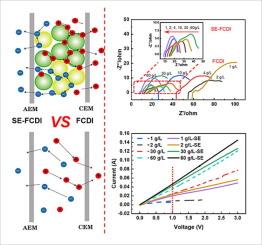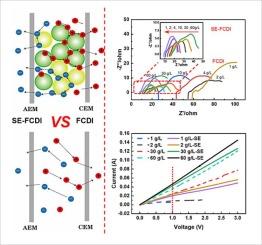利用固体电解质辅助流动电极电容去离子技术高效脱盐微咸水
IF 9
1区 工程技术
Q1 ENGINEERING, CHEMICAL
引用次数: 0
摘要
流动电极电容去离子(FCDI)有望实现高能效的咸淡水脱盐。尽管在流动电极和流动通道结构优化方面取得了相当大的研究成果,但由于微咸水固有的低电导率,关键的动力学指标平均除盐率(ASRR)的改善有限。本文报道了一种新型固体电解质辅助FCDI器件(SE-FCDI),该器件通过增强离子输运和降低浓度极化来解决电导率问题。当施加电压为1.0 V时,SE-FCDI对1 g/L盐水的ASRR为4.8μmol cm−2 min−1,是传统FCDI的4倍以上。再加上其较高的电流效率96% %,低能耗0.25 千瓦时/立方米实现饮用水生产。固体电解质策略为高效高速率半咸水脱盐的fdi设计和优化提供了新的见解,可以与fdi的其他创新相结合,进一步提高半咸水脱盐的整体性能。本文章由计算机程序翻译,如有差异,请以英文原文为准。


Efficient high-rate brackish water desalination via solid-electrolyte-assisted flow-electrode capacitive deionization
Flow-electrode capacitive deionization (FCDI) holds promise for energy-efficient brackish water desalination. Despite the considerable research effects on flow-electrode and flow-channel structure optimization, the key kinetic indicator, the average salt removal rate (ASRR), has seen limited improvement due to the intrinsically low conductivity of brackish water. We hereby report a new solid-electrolyte-assisted FCDI device (SE-FCDI), which tackles the conductivity issue by its enhanced ion transport and reduced concentration polarization. At applied voltage of 1.0 V, SE-FCDI shows a record-high ASRR of 4.8μmol cm−2 min−1 for 1 g/L saline water, which is over four times higher than conventional FCDI. Coupled with its higher current efficiency of 96 %, low energy consumption of 0.25 kWh/m3 is achieved for potable water production. The solid electrolyte strategy provides new insights into the design and optimization of FCDI for efficient high-rate brackish water desalination, which can be combined with other innovations in FCDI to further boost the overall performances of brackish water desalination.
求助全文
通过发布文献求助,成功后即可免费获取论文全文。
去求助
来源期刊

Separation and Purification Technology
工程技术-工程:化工
CiteScore
14.00
自引率
12.80%
发文量
2347
审稿时长
43 days
期刊介绍:
Separation and Purification Technology is a premier journal committed to sharing innovative methods for separation and purification in chemical and environmental engineering, encompassing both homogeneous solutions and heterogeneous mixtures. Our scope includes the separation and/or purification of liquids, vapors, and gases, as well as carbon capture and separation techniques. However, it's important to note that methods solely intended for analytical purposes are not within the scope of the journal. Additionally, disciplines such as soil science, polymer science, and metallurgy fall outside the purview of Separation and Purification Technology. Join us in advancing the field of separation and purification methods for sustainable solutions in chemical and environmental engineering.
 求助内容:
求助内容: 应助结果提醒方式:
应助结果提醒方式:


